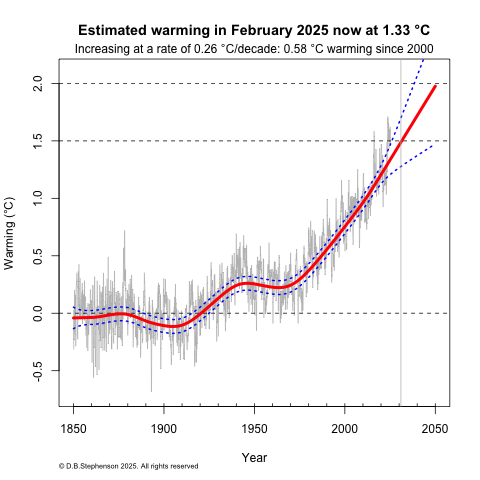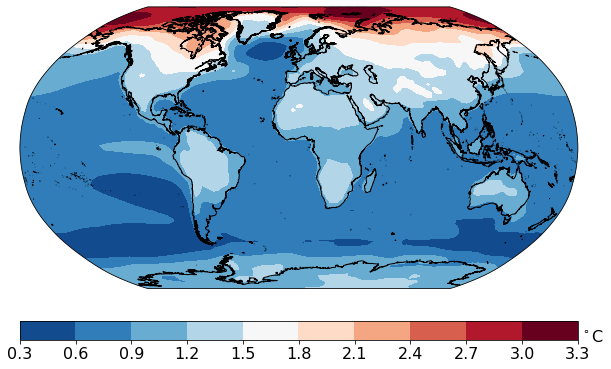Explainer: The 1.5°C global mean warming target
The RSS has launched a series of explainers on the statistics and data underpinning our understanding of climate change, led by the RSS Climate Change and Net Zero Task Force. This first set of explainers focuses on the 1.5°C global mean warming target.
1. How is the 1.5℃ global mean warming target defined?
The 1.5℃ target is an agreement to try and limit average global warming to safer levels. The target is reached once the estimated trend in global mean temperature exceeds 1.5℃ above the pre-industrial baseline. Global mean temperature is estimated each month by averaging surface air temperature and sea temperature measurements for that month across the whole globe. Temperatures relative to the pre-industrial period are then created by subtracting the long-term mean over a given period, e.g. 1850-1900. This is shown by the grey lines in the chart below.

Figure 1: Monthly global mean temperatures relative to the pre-industrial period (grey) with estimated trend (red) and 95% confidence band (blue dashed lines).
Finally, year-to-year variations are smoothed out by estimating a long-term trend e.g. the red line in the chart above (with its 95% confidence interval shown by the blue dashed lines). It is important to note that the trend in global mean temperature is an average over space and time and so by the time the trend in global mean temperature reaches 1.5℃ many locations will have experienced warming that is considerably more than this. How best to define the global mean warming trend is an area of ongoing research, but current data suggest that the trend might exceed 1.5℃ within the next 10 to 15 years, if not before.
Details of how this chart is produced, and updated versions can be found here.
2. What are the main sources of uncertainty in knowing when this target will be exceeded?
When this target might be met is not perfectly defined because of various unavoidable sources of uncertainty in the global mean temperature warming trend. The trend depends on imperfect and incomplete measurements of actual temperatures, the choice of which surface temperature data is used and how gaps between measurement locations are filled and averaged, the choice of pre-industrial time period to act as a baseline for comparison, and the choice of trend method. This uncertainty does not invalidate the utility of this target but is an area of active research that could benefit from more statistical reasoning (Betts et al. 2023).
3. What are the local warming implications of reaching such a target?
A warming of 1.5℃ might not seem that large but it is important to recognise that this is a mean warming in temperatures over the whole globe averaged over several decades. Warming values in any particular month or year can differ considerably from the long-term trend, for example, global mean warming already exceeded 1.5℃ for six consecutive months from July to December 2023 and in February and March 2016. Furthermore, temperature variations are not uniform over the whole globe - there are localised hot spots at any particular time, and the warming trend is greater over land areas especially at high latitudes and in the interior of continents (e.g., Figure 2 that shows considerable warming especially over the Arctic and surrounding regions).
A consequence of this is that a small change in global mean warming can substantially increase the rate of occurrence of extreme temperature events and the chance of experiencing multiple extreme events (heatwaves). Furthermore, the warming is occurring over the whole planet and so greatly increases the collective risk of record-breaking extreme temperatures simultaneously occurring at one or more locations.

Figure 2. Pattern of warming: degrees C of expected increase for each degree C of global temperature increase to 2100. Warming is fastest in the northern latitudes. Source: Chen, X., Raftery, A.E., Battisti, D.S. and Liu, P.R. (2022). Long-Term Probabilistic Temperature Projections for All Locations. Climate Dynamics 60: 2303--2314.
4. When and why was this particular target chosen?
At the 2015 United Nations Climate Change Conference in Paris (COP21), 195 nations signed up to the Paris Agreement. The overarching goal of the Paris Agreement is to halt “the increase in the global average temperature to well below 2°C above pre-industrial levels”. It also includes the commitment to pursue efforts to “limit the temperature increase to 1.5°C above pre-industrial levels”. It is the first legally-binding international agreement to combat climate change.
The period 1850-1900 is most commonly used for the pre-industrial baseline due to it pre-dating the large increases in human-induced greenhouse gas concentrations while also having a sufficient number, and geographical spread, of temperature measurements.
The target of 1.5°C comes from research and reports that predict the impact of different degrees of climate change on sea levels, extreme weather, agriculture, ecosystems, society and the economy. Greater warming leads to worse consequences; less warming avoids the most extreme effects of climate change.
The Intergovernmental Panel on Climate Change (IPCC) found that keeping warming to 1.5°C would help avoid the worst climate impacts and catastrophic risks. At 2°C, there would be widespread and severe impacts on people and nature, for example a third of the world’s population would be exposed to severe heat, Arctic sea ice would melt entirely at least one summer per decade, and warm water coral reefs would be destroyed. We also cannot rule out the possibility that irreversible loss of ice sheets in Greenland and the Antarctic could be triggered, leading to several metres of sea level rise over centuries to come. At 1.5°C the impacts would be serious, but less severe.
The value of 1.5°C was chosen as a goal for the international community to work towards together, but we know that every avoided fraction of a degree makes a substantive difference to the severity of climate impacts and reducing the risk of drastic, abrupt and irreversible changes, which can’t be ruled out between 1.5°C and 2°C of warming.